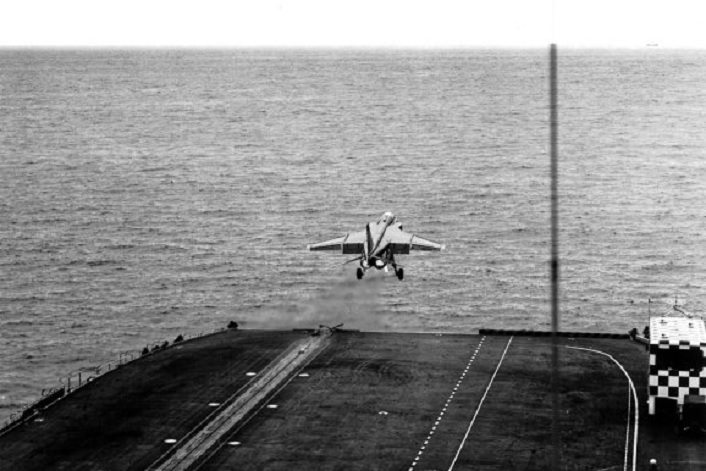French Navy opted to buy the Super Etendard which was no better or worse than the Jaguar M, but yet again it was the chance to buy a solely home grown product against one jointly developed with the British
Taken in 1970, the interesting footage in this post shows the trials of the short-lived Jaguar M aboard the French carrier Clemenceau.
Noteworthy the Jaguar M was the only variant of the type to incorporate a number of modifications. The aircraft had to conduct trials to look at the chance of the Jaguar M being operated by the French Navy from its aircraft carriers. The Jaguar M could perform lightweight strike operations and appear ideally suited to the role with its strong undercarriage, ability to carry a useful weapon load, and also the lower cost and that development were well underway. Politically it was better than purchasing aircraft from the U.S.
As explained by Glenn Ashley says in his book SEPECAT Jaguar In Action, the Jaguar M differed from the S by way of having an extendable twin nose wheel, single main wheels on strengthened undercarriage legs. Also, it was fitted with a 5..5-G capable arrestor hook and catapult fittings under the lower forward fuselage.
The sole Jaguar M, M05/F-ZWRJ, made its maiden flight on Nov. 14, 1969, at Melun-Villaroche with an initial flight lasting about an hour. The aircraft was then flown to Bedford in England for trials on the land-based deck set up there. The trials were a success and so the aircraft proceeded to the next stage, full sea trials.

For the purpose of sea trials, the French Navy had made the carrier Clemenceau available, and on Jul. 8 the Jaguar M made its first true carrier deck landing. For the next couple of days, checks were made to see that no stress damage had been inflicted on the aircraft, and on Jul. 10 the aircraft was prepared for its first catapult launch. This took place without a hitch, and so the trials continued until Jul. 13 by which 12 take off and landings had been completed.
Towards the end of July, the aircraft returned to Bedford to carry out preparatory trials for carrier operations with various stores fitted.
On Oct. 20 the second series of trials began aboard Clemenceau, and it was during these trials that disaster very nearly struck.
The Jaguar failed to catch the arrestor wire and was struggling to gain enough power to lift cleanly from the deck in order to make another approach to the wire. The pilot just managed to keep the aircraft from hitting the water and managed to make a successful landing on the second attempt. The cause of the near-crash was put down to the slow response from the throttle and engines which left the French Naval officials less than impressed.
Another problem that was creeping in was the growing development costs which would mean that only half the planned order would be able to be bought. Even more so when the final cost was measured against purchasing A-4 Skyhawks or A-7 Corsairs from the U.S. Finally, the Navy’s patience snapped and they announced that they would be buying the Super Etendard, against the wishes of the French Government. The Etendard was no better or worse than the Jaguar, but yet again it was the chance to buy a solely homegrown product against one jointly developed with the British.
The prototype Jaguar M was then simply reduced to flying tests with the Navy before it made its last flight on Dec. 12, 1975. It was delivered to Rochefort to become a ground instructional machine.
Photo by BAE Systems

